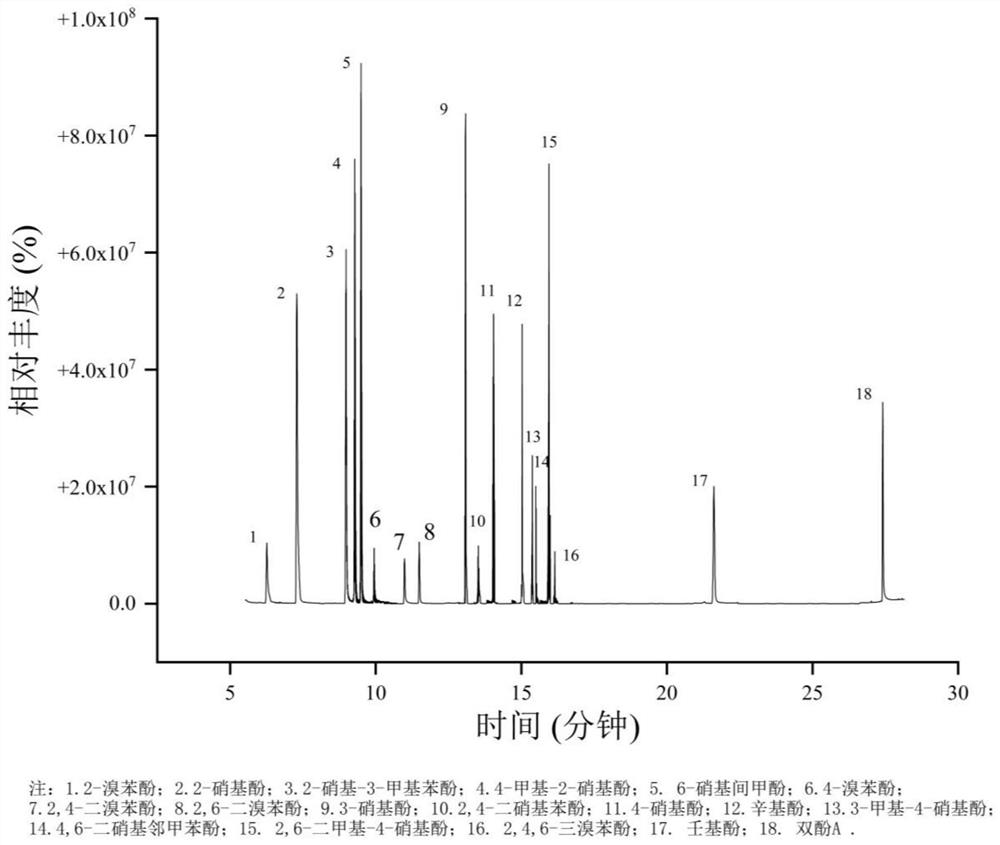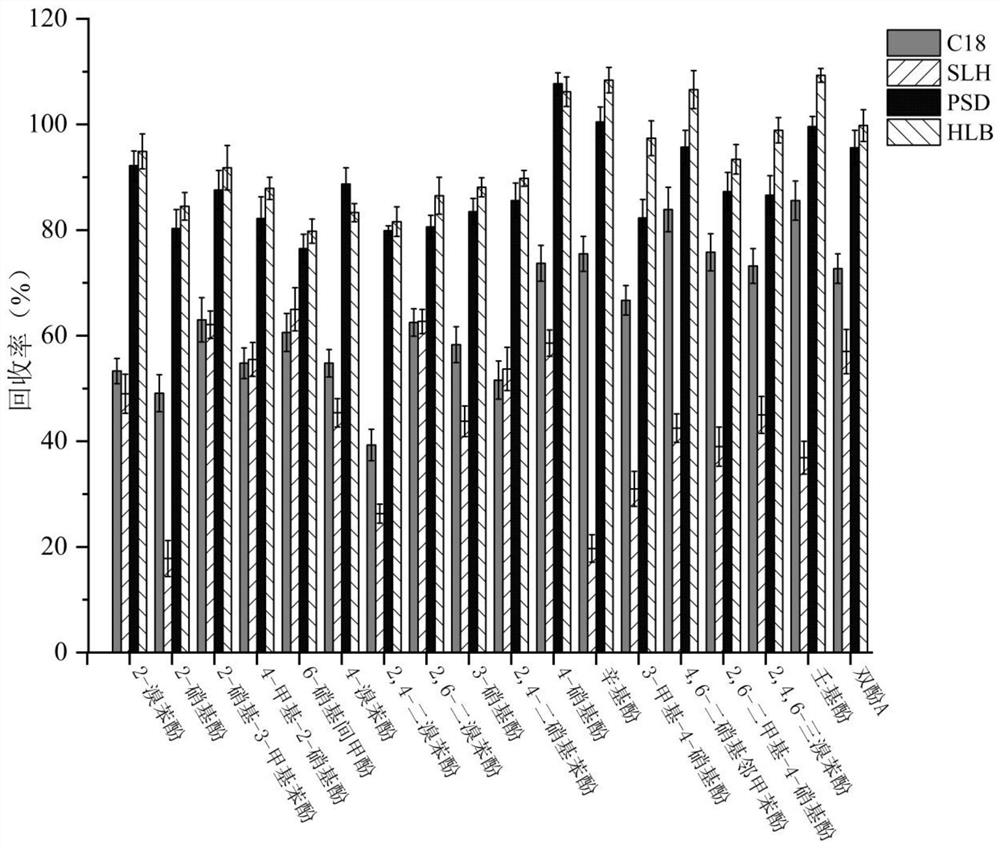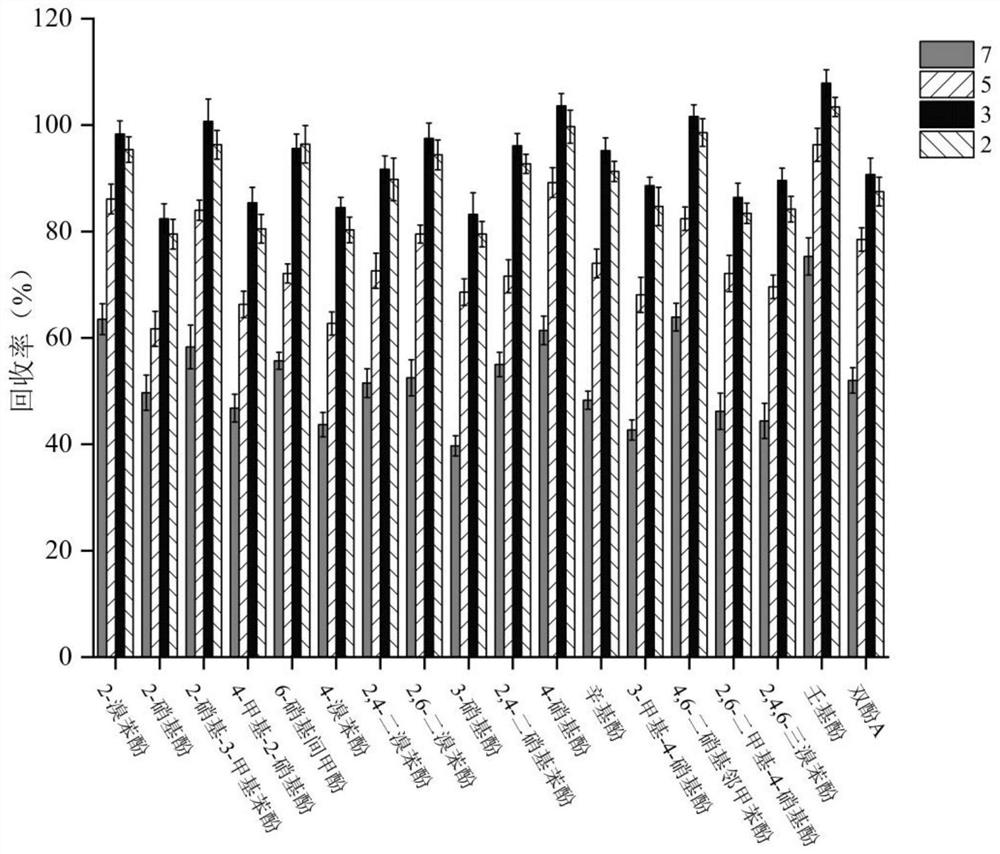A kind of method for detecting phenolic compounds in water
A technology for phenolic compounds and water samples, which is applied in the field of water pollution detection, can solve the problems of complex derivation operations, harsh reaction conditions, and low detection limits, and achieve the effects of improved analysis rate, simple method, and high accuracy
- Summary
- Abstract
- Description
- Claims
- Application Information
AI Technical Summary
Problems solved by technology
Method used
Image
Examples
Embodiment 1
[0027] (1) Preparation of standard solution
[0028] Using methanol as a solvent, the standard samples of alkylphenol, bromophenol and 10 kinds of nitrophenols were prepared into 10mL of 1g / L stock solution, and then the 1g / L stock solution was diluted with methanol to 100mg / L intermediate solution; Draw the intermediate solution at a ratio of 1:10 to prepare a mixed standard solution with the concentrations of the first type phenols and the second type phenols at 1 and 10 mg / L, respectively. The above stock solutions and intermediate solutions are stored at -10 °C. ,spare.
[0029] Accurately draw an appropriate amount of the 18 mixed standard solutions, and dilute them with methanol to obtain the concentration of the first type phenols are 0.50, 1.00, 5.00, 10.00, 20.00 μg / L, and the second type phenols are 5.00, 10.00, 50.00, 100.00 , 200.00μg / L mixed standard solution.
[0030] Wherein, the first type of phenolic substances are: Nonylphenol (Nonylphenol, NP), Bisphenol A...
Embodiment 2
[0042] Embodiment 2: a kind of method for detecting phenolic compounds in water
[0043] (1) Sample pretreatment: enrichment of phenolic compounds
[0044] Use hydrochloric acid to adjust the pH of the water sample to be tested to 3.0, activate the solid-phase extraction cartridge (OasisPRiME HLB 3cc) with 6 mL of methanol and 6 mL of ultrapure water, then add the water sample to be tested into the cartridge, adjust the solid-phase extractor to ensure that the water The sample flows through the column at a rate of 1 mL / min. Before the end of the sample loading, make sure that the small column does not dry during the whole process. After the sampling is completed, continue the negative pressure suction filtration for about 15 minutes, and finally add 10 mL of ethyl acetate to the column in turn, soak it. After 2min, rely on gravity elution, collect the eluate into a test tube, blow nitrogen to about 0.8mL, dilute to 1mL, pass through an organic membrane, and wait for testing. ...
Embodiment 3
[0048] Example 3: Optimization of Solid Phase Extraction Conditions
[0049] (1) Solid phase extraction cartridge selection
[0050] Select C18 column, SLH column, PSD column and HLB column respectively, and carry out pretreatment according to the corresponding experimental steps. The results obtained after measurement are shown in Table 2, figure 2 . Depend on figure 2 It can be seen that the recovery rate of phenolic compounds is the highest when the HLB column is used for solid phase extraction, so the HLB solid phase extraction column is selected.
[0051] Table 2 Effects of different cartridges on the recovery of phenolic compounds (n=3)
[0052]
[0053] (2) Selection of initial pH value
[0054] Adjust the pH of 3 parallel samples to 7, 6, 5, 4, 3, and 2 with hydrochloric acid respectively, and carry out pretreatment according to the corresponding experimental steps. The results obtained after the measurement are shown in Table 3, image 3 . Depend on image...
PUM
| Property | Measurement | Unit |
|---|---|---|
| linear range | aaaaa | aaaaa |
| recovery rate | aaaaa | aaaaa |
Abstract
Description
Claims
Application Information
 Login to View More
Login to View More - R&D
- Intellectual Property
- Life Sciences
- Materials
- Tech Scout
- Unparalleled Data Quality
- Higher Quality Content
- 60% Fewer Hallucinations
Browse by: Latest US Patents, China's latest patents, Technical Efficacy Thesaurus, Application Domain, Technology Topic, Popular Technical Reports.
© 2025 PatSnap. All rights reserved.Legal|Privacy policy|Modern Slavery Act Transparency Statement|Sitemap|About US| Contact US: help@patsnap.com



